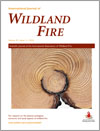International Journal of Wildland Fire
Volume 25
Number 11 2016
Distinct historical fire regimes with evidence of an anthropogenic influence exist between the Subalpine, Montane and Upper Foothills of southern Alberta. Post-1948 median fire return intervals have departed by up to 223% in the Montane and Foothills, while the Subalpine had a 42% departure in the most rugged region.
We investigated the effect of human development on the area burned in Alberta over a 31-year period. We tested the importance of several human factors. Our results point to a possible ‘ecological frontier’ in which human ignitions increase landscape fire susceptibility in areas where recent industrial expansion and forested wildlands overlap.
Time after wildfire is often discussed as an opportunity for policy change and adaptation, where new regulations and rebuilding can transform the wildland–urban interface, reducing future risk. Our study of recovery post-fire in Colorado found some evidence of adaptation, but also extensive reinvestment in hazard-prone environments, supported by local governments.
Fuel component semivariance increased with particle diameter regardless of stand condition, with stand-level fuel component loading providing strong predictions (R2 = 0.99). Spatial scales of autocorrelation followed closely (R2 = 0.88) with fuel particle diameter. Incorporating spatial knowledge into fuel sampling will improve fire modelling and wildlife habitat assessments over singular stand-level means.
We present a probabilistic model for forecasting expected number of significant wildfire events for the upcoming week for the Western United States. The procedure may be used to provide daily maps of fire risk with expected number and quantiles of significant fires in each risk category.
In this paper, proper orthogonal decomposition is applied for the first time to the prediction of fire evolution by physical modelling. The paper shows how this reduction method is able to dramatically reduce the computational cost of physical models without causing the loss of important information.
Visual assessment of forest fuels is often used to estimate fuel load and predict fire behaviour. More than 500 visual assessments were compared against destructively sampled fuel loads, showing poor correlation between the two and highlighting several serious deficiencies in the operational fuel hazard assessment process.
Extreme soil heating is a concern to forest managers. Temperatures lethal to fine roots and soil organisms were measured beneath combusted mega-logs to at least 10 cm for about 7 hours. Soils in a broadcast burn of masticated fuels experienced lethal temperatures in most cases only at the surface for about an hour.




